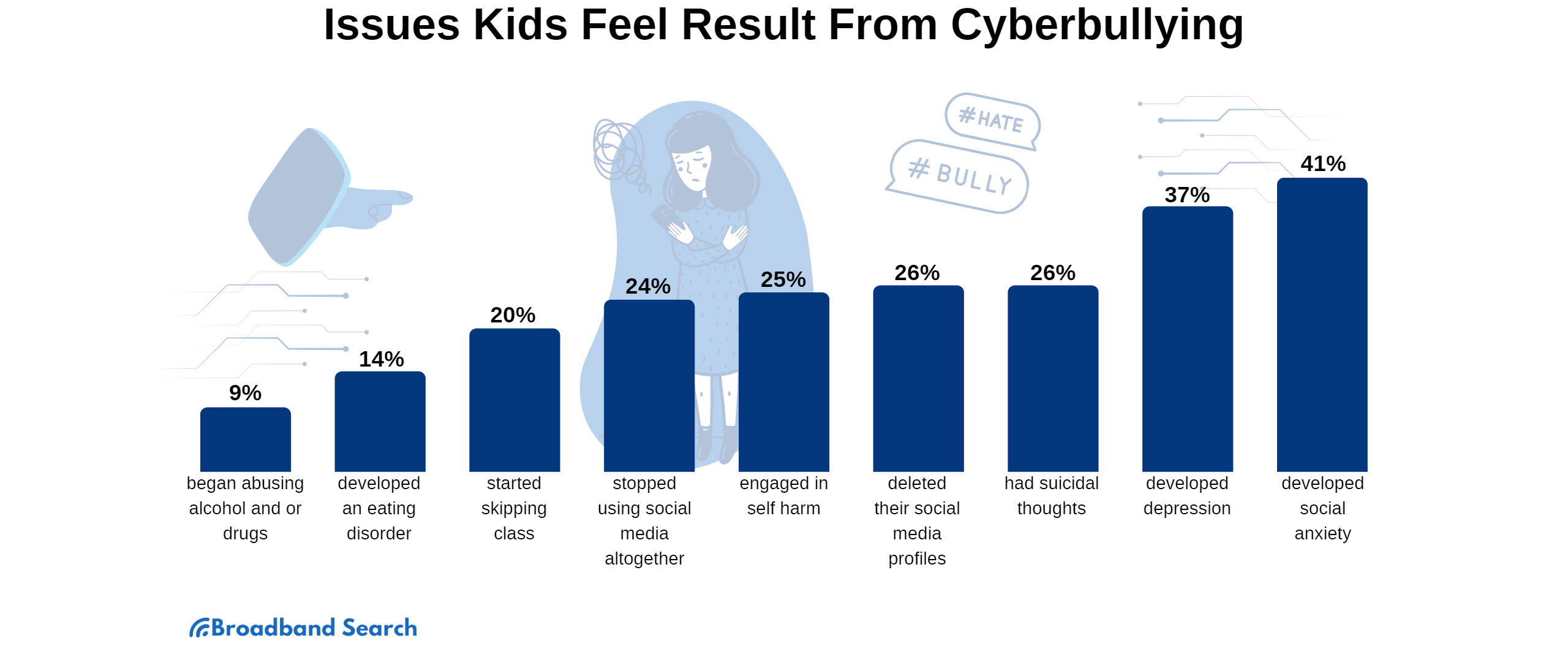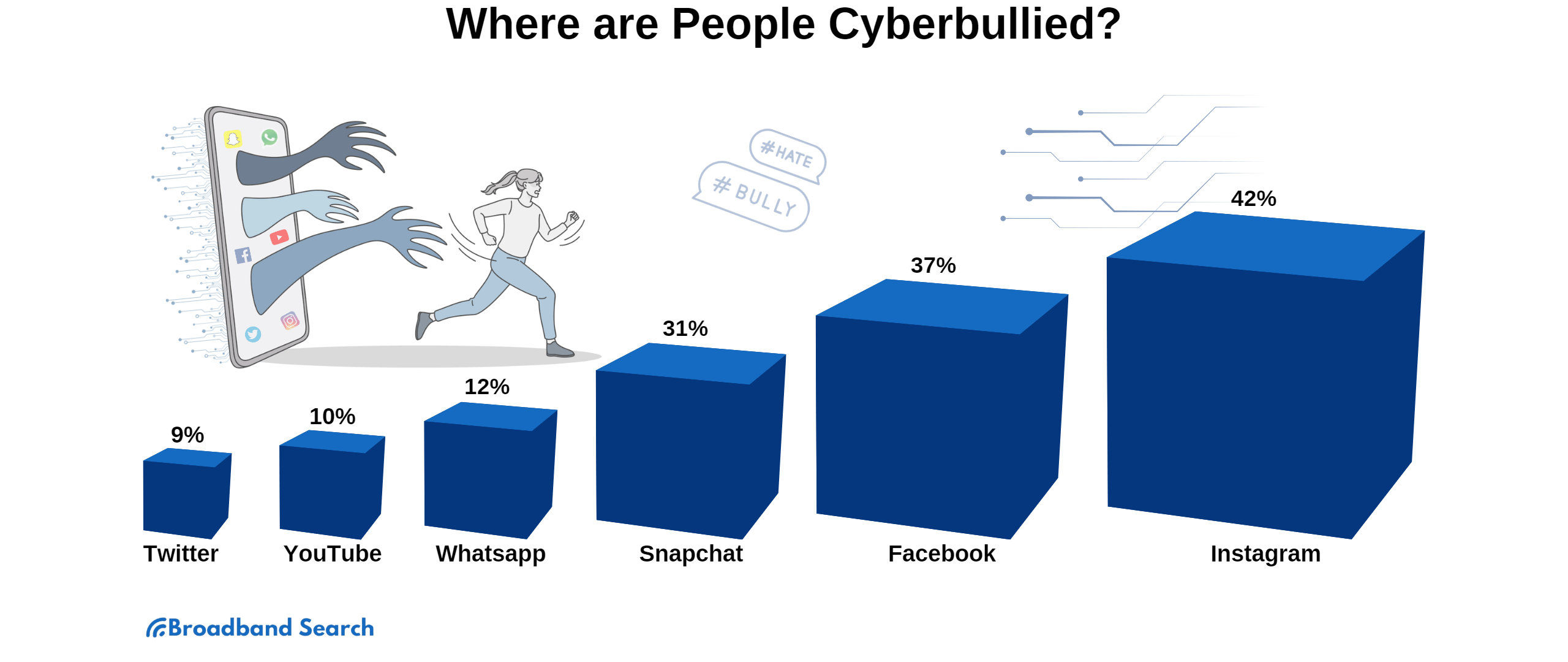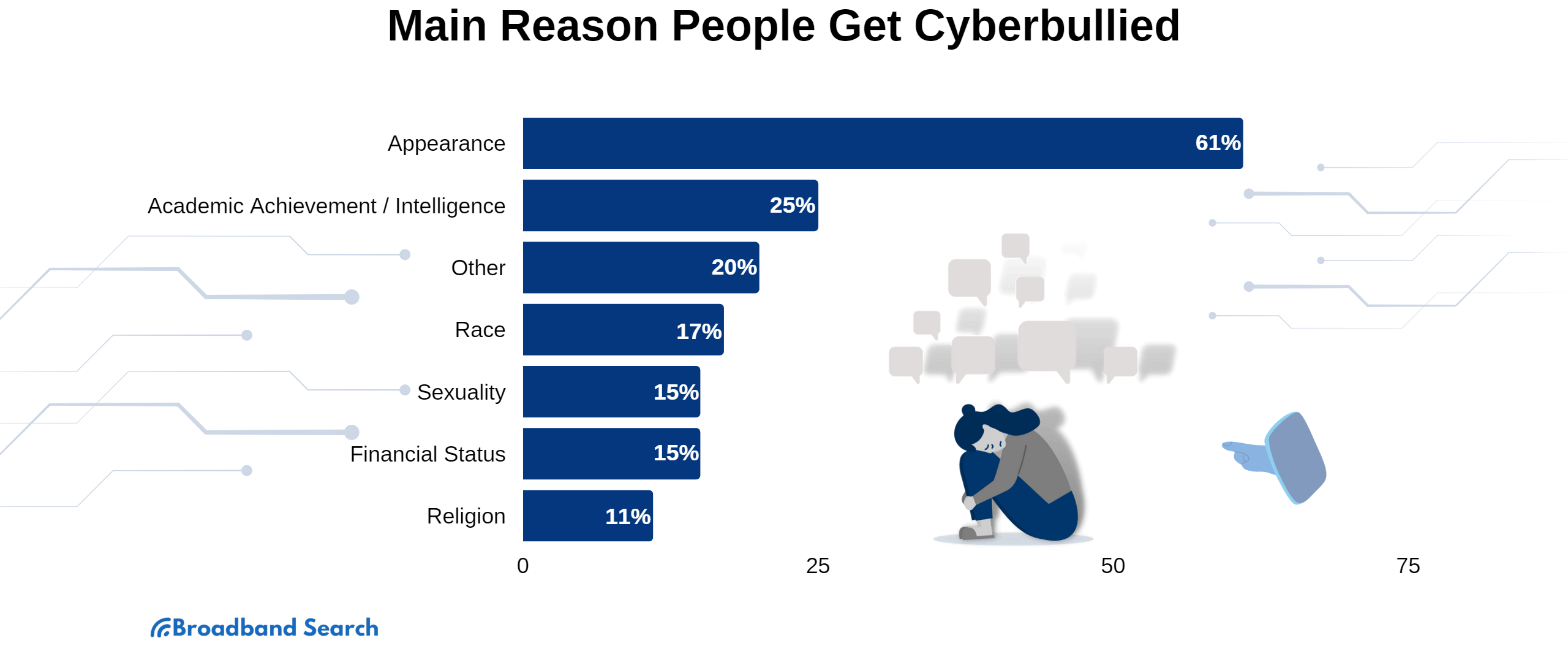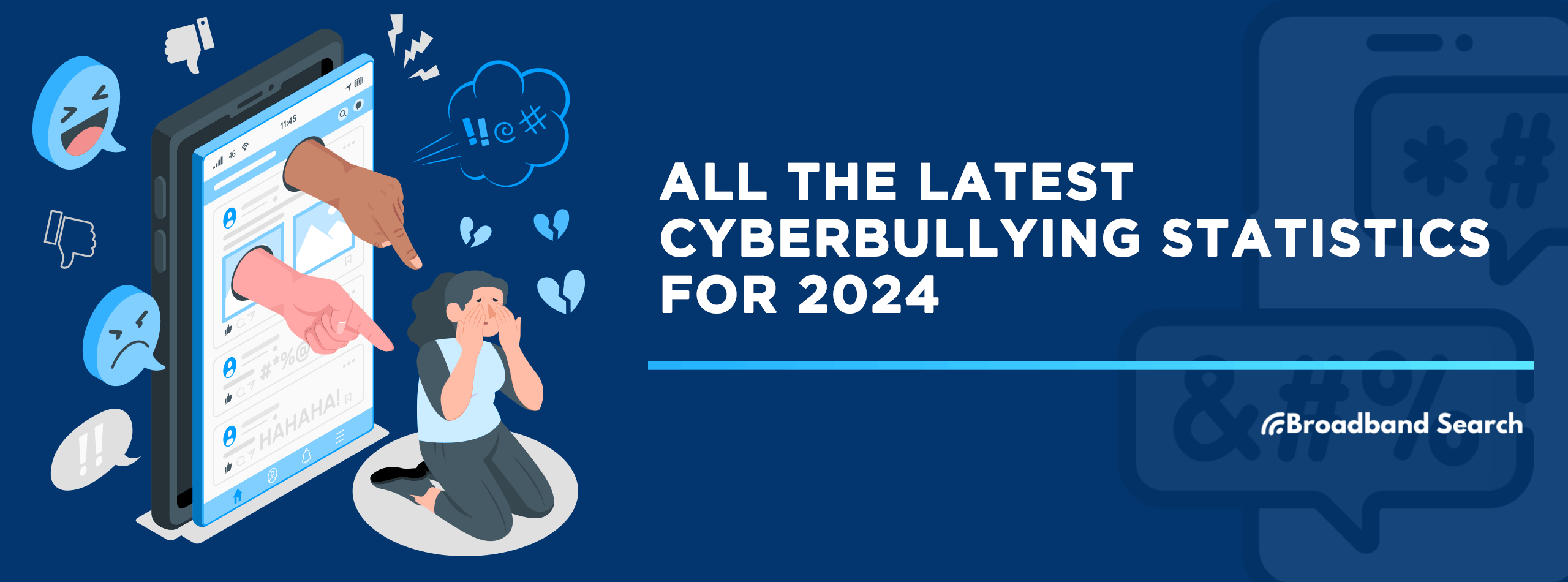As the world turns to more technology innovation, our lives are also becoming digitalized. The Covid-19 pandemic has meant that we conduct more of our daily existences over the internet than ever before.

In general, this is a good thing. Digital technologies make our lives easier and facilitate business, communication, government, and much more. However, as is the case with most things, with the good also comes the bad, and one negative result of internet use is cyberbullying.
What is Cyberbullying?
As the name implies, cyberbullying is bullying in a digital space, such as on mobile phones, computers, tablets, etc., in arenas such as text messaging, social media, forums, online gaming, and more.
Even in the past year, bullying is still a problem for most people. 73 percent of students feel they were bullied in their lifetime, and 44 percent say it's happened in the last 30 days.
It should come as no surprise that cyberbullying has become a major issue. All that has happened is that an age-old problem has made its way into the digital world.
One could argue that cyberbullying is more damaging than traditional in-person bullying because it can happen anytime. The words people use to bully are in the digital space, so cyberbullying is more challenging to spot, meaning it often goes unnoticed.
To see how big of a problem this is, here are all the statistics about cyberbullying that you need to know:
Cyberbullying in the Past Year
Cyberbullying is a real problem in today's society. Consider that:

Sources: [1], [2], [3], [4], [5]
An Imminent Threat
These numbers show that cyberbullying is not some tiny problem experienced by just a select few individuals but is a widespread societal issue. Therefore, we all must understand cyberbullying, why it happens, how to stop it, and how to help victims.
Want to add a layer of protection to your kid's device while surfing the internet? There are internet service providers that offer just that! Upgrade and lessen your worry when your child browses the internet.
It's Not Just Children
Although a lot of the cyberbullying focus is on kids, mainly because this group is most vulnerable to the long-term impacts of cyberbullying, they are not the only victims.
Adults are often guilty of or subjected to cyberbullying. However, cyberbullying is usually called something else when done to adults, such as harassment or sometimes even stalking.
To give you an idea of how prevalent these problems are, sixteen percent of women and one in 19 men have been stalked at some point in their lifetime. Four in ten Americans have experienced some form of online harassment.
Also, consider that:
- A published post by The Sunday Morning Herald states that in Australia, around ten percent of adults admit to having been victims of cyberbullying.
- According to the data from Pew Research Center, in the U.S., 40 percent of adults have personally experienced some form of online harassment, and 75 percent of adults have seen cyberbullying around them.
These numbers are troubling. It shows that cyberbullying is pervasive and doesn't disappear as we age. Perhaps what it highlights the most is that being nice to one another is what our global society needs more than anything.
More Cyberbullying Statistics Everyone Should Know
At this point, it should be clear that cyberbullying is a significant problem in today's society. But where does cyberbullying occur?
To get a little bit deeper into the problems cyberbullying causes, look at the following data provided by Ditch the Label, one of the world's leading anti-bullying organizations.
They asked students to indicate on which social media platforms they had experienced cyberbullying, and here are the results:

The study also revealed some surprising statistics about the number of people that are perpetrators of cyberbullying. For example, they found that:
- 69 percent of people report having done something abusive towards others online.
- 15 percent of people admit to having cyberbullied someone else online.
These statistics are troubling because it suggests a general misunderstanding of precisely what cyberbullying is.
More specifically, it's likely these people who have admitted to doing something abusive towards others online actually engaged in cyberbullying. Still, because of a lack of awareness about this, they do not admit it.
Here are some more cyberbullying statistics to consider:
- According to StopBullying.gov, over half of students who identify as being LGBTQ have experienced cyberbullying at some point.
- Girls are more likely to be a victim of cyberbullying than boys. Overall, around 36 percent of girls have reported being cyberbullied compared to 26 percent of boys, according to a report from Pew Research Center.
- While a report from Florida Atlantic University states that 83 percent of those bullied online have also been bullied in person, and 69 percent who admitted to bullying online have also admitted to in-person bullying.
Why are People Cyberbullied?
To tackle the problem of bullying and cyberbullying, it's essential to look at why people are cyberbullied. The graph below shows us some of the main reasons why people get attacked online:

Based on these details, we can see that people are bullied online primarily because of their physical appearance, status, and preferences.
The Impacts of Cyberbullying
The effects of cyberbullying can have a tremendously negative impact on the mental health and well-being of victims. These impacts are far more severe than "feeling bad" about yourself. They go deeper and touch more sensitive parts of the human psyche.
Victims can feel these effects in the short and long term, and they help point out why we should take cyberbullying so seriously.
Here is a rundown of some troubling statistics about the impact of cyberbullying:
- From the data of Cyberbullying Research Center, 64 percent of people who have been cyberbullied say it affects their ability to learn and feel safe at school.
- A Center for Disease Control study claims that students who experience cyberbullying are more likely to have trouble adjusting to school. They are also more likely to have mental health and behavior problems.
- A research study by Gini and Pozzoli, 2013 states that bullied students are twice as likely as other students to experience problems such as headaches and stomach aches.
- According to an article published by National Center for Education Statistics,19 percent of bullied students say the experience negatively impacted their feelings. 14 percent say it has negatively impacted their relationships with friends and family, and 9 percent reported a negative impact on their schoolwork.
What's perhaps more concerning, though, is the impact cyberbullying has on the one doing the actual bullying.
According to a study published in The Journal of Early Adolescence, cyberbullying can help improve a student's perceived popularity. This suggests that we, as a society, encourage this behavior by rewarding those who engage in it with higher social standing.
The Results of Cyberbullying
Below are other impacts that, according to students, were a result of the cyberbullying they had experienced:
- 25 percent of teens have had an online bullying experience that culminated in a face-to-face confrontation.
- 13 percent reported cyberbullying made them concerned about going to school the next day.
- 8 percent reported having physical altercations with someone because of something on a social network.
- 6 percent reported another student sending an instant message or chat to hurt their feelings.
- 4 percent reported having something put on a profile page to hurt their feelings.
- 3 percent reported receiving a nasty email from another student.
How Can You Tell if Someone is Being Cyberbullied?
People who suffer from cyberbullying are unlikely to say anything about it; that is why it is crucial to know the detrimental effects of cyberbullying and the signs that someone is suffering. We can offer help wherein the victims are often too shy or embarrassed to ask for it.
According to the National Crime Prevention Center (NCPC), there are several behavioral changes that someone being cyberbullied may undergo. For example, they may:
- Become shy and withdrawn
- Became moody, agitated, anxious, or stressed out
- Act more aggressively towards others
- Protest more about going to school
- Get into trouble at school
- Skip school
- Experience a dip in academic performance
- Have stopped using the computer or other devices that connect to the internet
- Change in eating and sleeping habits. For example, they may begin experiencing nightmares
- Attempts self-harm or threatens suicide
- Suddenly started hanging out with a new group of friends
This is one of the biggest red flags because kids are connected to their devices. If you notice a significant change, you must ask them what they are experiencing.
Recognizing Cyberbullies
On the other side of things, it's essential to look out for some of the signs that someone is engaging in cyberbullying.
As shown by the statistics, more people engage in cyberbullying than you might think, and these numbers are based on those who admit it. There may be more people than the research suggests.
It's tricky to determine when someone is engaging in cyberbullying, but it's not impossible. Typically, children, or adults, who are engaging in cyberbullying will:
- Stop using their computer or phone when someone comes near them
- Look nervous or jumpy when online
- Be secretive about what they are doing online
- Spend an excessive amount of time on the computer
- Become angry or upset when internet privileges are taken away (this is more the case with children than adults)
If you see anyone exhibiting these types of behaviors, then consider investigating more and intervening where possible.
What Should You Do if You Believe Someone is a Victim of Cyberbullying?
As of last year, around 81 percent of kids think that bullying is easier to get away with online. Part of this could be that 90 percent of kids who see cyberbullying ignore it.
However, 84 percent of students report having seen someone stand up to a cyberbully to tell them to stop what they are doing.
This suggests that only a small group of people speak up about cyberbullying, which needs to change.
As an adult, if you see a kid being cyberbullied, consider doing one of the following:
- Ask your child to go over their list of contacts on their phone and instant messaging apps so that you can know more about the people with whom they communicate.
- Talk to your kids about cyberbullying, so they know what it is and how to understand when it is happening.
- Emphasize to kids that they will not lose internet privileges if they are being cyberbullied. Believe it or not, this is the main reason kids choose not to speak up about cyberbullying, according to the NCPC.
- Raise the issue with teachers and school administrators to look for signs of bullying in school and address the problem in the best way possible.
- Reach out to your child's friends. An engaging bystander is a key component of fighting bullying, so those who witness the abuse know what they are seeing and how to react.
Those being cyberbullied have options, too. Ensure kids know this by going over what they should be doing if they feel they are a victim. Some things you can do if you think you're being cyberbullied are:
- Tell someone you trust about what's going on so that you can get some help.
- Keep emails, texts, comments, etc., that could be evidence of cyberbullying.
- Don't strike back. Two wrongs don't make a right.
- Report the issue to the website. For example, Facebook and YouTube both have places where you can report cyberbullying in a safe environment.
Final Thoughts
As you can see, cyberbullying is a significant issue in every society worldwide, and it isn't something that only kids have to deal with. Everyone might experience these challenges too.
Hopefully, these statistics have helped you see how serious this problem is and what could be your role in addressing it. Keep an eye out in your digital communities, and if you see someone acting towards someone else in a harmful way, say something. You might just save their life.
FAQ
Which group has the highest risk of being cyberbullied?
The most likely demographic to be cyberbullied is a white, homosexual, 9th-grade girl.
Which group has the highest chance of being a cyberbully?
Strangely, or perhaps not, it turns out that girls tend to be the cyberbully most often as well, especially towards their former friends or dating partners. More research is needed in this area, but these are the initial results.
Does a single incident count as bullying?
Technically, no. An important part of defining either bullying or cyberbullying is its repetitive nature. Though a single instance can certainly be painful, it is not defined as bullying until it has been shown to happen recurrently.
Can adults get cyberbullied?
The Cyberbullying Research Center says cyberbullying as a term should generally only be applied to interactions between adolescent peers. While the same behaviors can certainly happen between adults, there is a distinction between that and when it happens to kids. For adults, the behavior is actually a crime like harassment or stalking.
What are the most common types of cyberbullying?
This is not a conclusive list, but the most frequent type of cyberbullying takes the form of flaming, outing, trolling, name calling, spreading false rumors, sending explicit images or messages, or cyberstalking (harassing or making physical threats).

